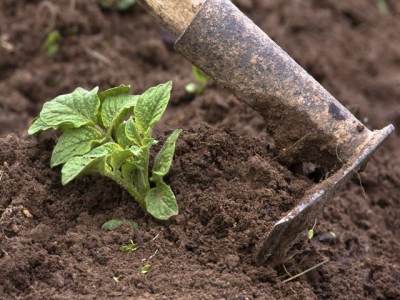Weed control and ridging of potatoes

Management of the potato crop after planting depends on various factors. One is weed control. The procedure you use will depend on what sort of weeds you can expect in the particular land.
If nutgrass (Cyperus) is present, for example, you will have to apply a suitable herbicide pre-emergence, which will control this pest. This usually means the herbicide will have to be irrigated into the soil prior to the shoots emerging from the bulbs. Nutgrass can grow right through tubers. In many cases, it may not be necessary to apply any herbicides, as weed control can be done mechanically. This requires good management and timing.
Moisture
Sometimes the soil can be rather flat after planting. When the leaf growth of the potatoes is tall enough to start ridging, this already constitutes a weeding, as it disturbs the young weeds in the ridger path and covers the weeds which have emerged between and around the plants. If the soil was relatively moist at planting, tubers may retain sufficient moisture for some time before irrigation is required.
Apart from nutgrass, the seeded weeds won’t start to germinate until it rains, or the land is irrigated. This can give you a strategic advantage with your weed control. Even where ridges are formed at planting, cultivation by further ridging can, in many cases, be adequate for weed control.
There’s no fixed formula and each farmer will have to determine how to go about weed control bearing in mind all these different factors. But the less costly this becomes, the more profit there is to be made. You always need to analyse the necessity of each procedure and ensure it will accomplish the task in the most cost-effective way.
Beds
If you plant on beds you may have to rely more on herbicides than with the single ridge method. If this seems like a disadvantage, there are other benefits to having beds. There’s less run-off from rainstorms and the drying out of the soil is less critical. However, it does require more expensive machinery and is more suited to larger operators.
Ridging isn’t just for weed control but is necessary to cover developing tubers which may protrude from the soil surface as they develop. The root system will grow downwards from the seed tuber, and the stolons, or modified stems, will grow out laterally from the developing stem of the seed potato, which is naturally above the potato. Swelling occurs at the tips of these stolons, which becomes the developing tuber.
The eyes on the potato are just like the eyes on the stems of trees and new shoots develop from them when induced to do so. In some varieties, the tubers form further from the plant and so have a greater tendency to protrude from the soil. They then develop chlorophyll, which means they turn green and become unmarketable. Apart from this, tubers too close to the surface are also at risk of becoming a target for tuber moth, which means they’re also downgraded.
Cracks
Soil which tends to crack as the tubers expand also invites tuber moth infestation. The moths enter the cracks to reach the tubers which may still be some way from the soil surface. If cracks start to develop, this may necessitate a further cultivation. Rainstorms can also fill the cracks, saving you some effort.
It’s also important to make sure you do all the cultivation at the correct moisture level of the soil. If it’s done when too wet, the operation will plaster the soil surface. If the clay content is a little high, this will result in clods developing when lifting, which complicates the whole process and can even bruise the tubers. Apart from this, any cultivation of any kind when soil is too moist will impair the soil structure.
Related news
 Climate, soil and potatoes
Climate, soil and potatoes Potatoes have to be ridged and lifted. These two operations can be troublesome with certain clay soil, especially when the weather doesn’t play along.
 Potato planting procedures
Potato planting procedures Potatoes are a productive crop and as such are heavy feeders. The potato also has a rather confined root system, so make sure the fertiliser is placed
 Why potato irrigation is so important
Why potato irrigation is so important As potatoes can have a confined and intense root system, together with a fairly large leaf area, it stands to reason irrigation requirements will differ from